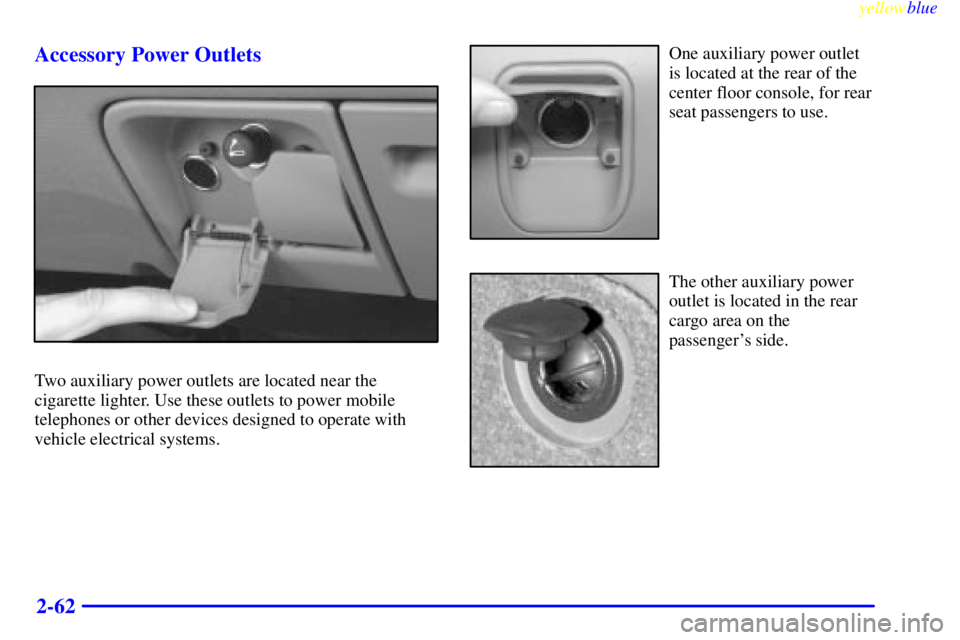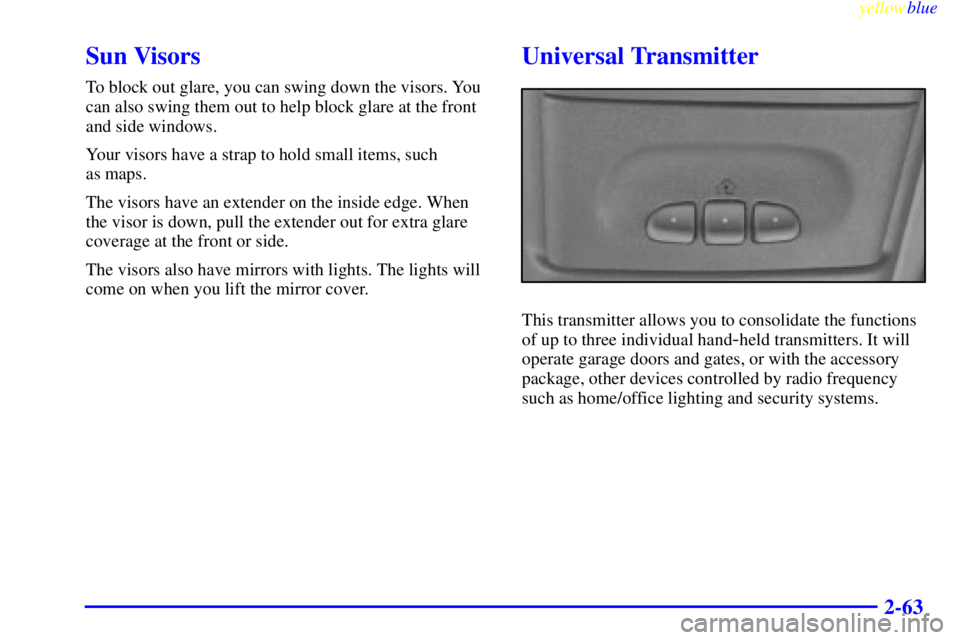1999 GMC YUKON light
[x] Cancel search: lightPage 126 of 400

yellowblue
2-62 Accessory Power Outlets
Two auxiliary power outlets are located near the
cigarette lighter. Use these outlets to power mobile
telephones or other devices designed to operate with
vehicle electrical systems.
One auxiliary power outlet
is located at the rear of the
center floor console, for rear
seat passengers to use.
The other auxiliary power
outlet is located in the rear
cargo area on the
passenger's side.
Page 127 of 400

yellowblue
2-63
Sun Visors
To block out glare, you can swing down the visors. You
can also swing them out to help block glare at the front
and side windows.
Your visors have a strap to hold small items, such
as maps.
The visors have an extender on the inside edge. When
the visor is down, pull the extender out for extra glare
coverage at the front or side.
The visors also have mirrors with lights. The lights will
come on when you lift the mirror cover.
Universal Transmitter
This transmitter allows you to consolidate the functions
of up to three individual hand
-held transmitters. It will
operate garage doors and gates, or with the accessory
package, other devices controlled by radio frequency
such as home/office lighting and security systems.
Page 128 of 400

yellowblue
2-64
The transmitter will learn and transmit the frequencies
of most current transmitters and is powered by your
vehicle's battery and charging system.
This device complies with Part 15 of the FCC Rules.
Operation is subject to the following two conditions:
(1) this device may not cause harmful interference,
and (2) this device must accept any interference
received, including interference that may cause
undesired operation.
This device complies with RSS
-210 of Industry Canada.
Operation is subject to the following two conditions:
(1) this device may not cause interference, and
(2) this device must accept any interference, including
interference that may cause undesired operation of
the device.
Changes and modifications to this system by other than
an authorized service facility could void authorization to
use this equipment.
Programming the Transmitter
Do not use the transmitter with any garage door opener
that does not have the ªstop and reverseº feature. This
includes any garage door opener model manufactured
before April 1, 1982.
Be sure that people and objects are clear of the garage
door you are programming.
Your vehicle's engine should be turned off while
programming the transmitter. Follow these steps to
program up to three channels.
1. If you have not previously programmed a universal
channel, proceed to Step 2. Otherwise, hold down
the two outside buttons on the universal transmitter
until the red light begins to flash rapidly
(approximately 20 seconds). Then release the
buttons. This procedure initializes the memory and
erases any previous settings for all three channels.
2. Hold the end of the hand
-held transmitter against the
bottom surface of the universal transmitter so that
you can still see the red light.
Page 129 of 400

yellowblue
2-65
3. Decide which one of the three channels you want to
program. Using both hands, press the hand
-held
transmitter button and the desired button on the
universal transmitter. Continue to hold both buttons
through Step 4.
4. Hold down both buttons until you see the red light
on the universal transmitter flash rapidly. The rapid
flashing, which could take up to 90 seconds,
indicates that the universal transmitter has been
programmed. Release both buttons once the light
starts flashing rapidly.
If you have trouble programming the universal
transmitter, make sure that you have followed the
directions exactly as described and that the battery in the
hand
-held transmitter is not dead. If you still cannot
program it, rotate the hand
-held transmitter end over end
and try again. The universal transmitter may not work
with older garage door openers that do not meet current
Federal Consumer Safety Standards. If you cannot
program the transmitter after repeated attempts, consult
your GM dealer.Be sure to keep the original hand
-held transmitter in
case you need to erase and reprogram the
universal transmitter.
Operating the Transmitter
Press and hold the appropriate button on the universal
transmitter. The red light comes on while the signal is
being transmitted.
The effective transmission range of the universal
transmitter may differ from the hand
-held transmitter
and from one channel to another.
Erasing Channels
To erase all three programmed channels, hold down the
two outside buttons until the red light begins to flash.
Individual channels cannot be erased, but can be
reprogrammed using the procedure for programming the
transmitter explained earlier.
Page 130 of 400

yellowblue
2-66 Training a Garage Door Opener with a
ªRolling Codeº Feature
If you programmed the universal transmitter, but the
garage door will not open, and if your garage door
opener was manufactured after 1995, your garage door
may have a security feature that changes the ªcodeº of
your garage door opener every time it is opened
or closed.
To determine if your garage door opener has this
ªrolling codeº feature, press the appropriate button on
the universal transmitter that was programmed. If the
red light flashes rapidly for one to two seconds, then
turns solid, your garage door opener has this feature.
To program a garage door opener with the rolling code
feature, do the following:
1. Program your hand
-held transmitter to the universal
transmitter by following the steps provided under
ªProgramming the Transmitterº earlier in
this section.2. Remove the cover panel from the garage door
opener receiver. It is located near the garage door
opener motor.
3. Locate the training button on the garage door opener
receiver. The exact location and color will vary
among brands.
4. Press the training button on the garage door opener
receiver for one to two seconds.
5. Return to your vehicle and press the programmed
button on the universal transmitter until the red light
flashes rapidly (about two seconds).
6. Release the button, then press it again to confirm
that it was programmed to the garage door
opener receiver.
You may now use either the universal transmitter or the
hand-held transmitter to open your garage door. If you
still have difficulty in programming and require
assistance, please call 1
-800-355-3515.
Page 136 of 400

yellowblue
2-72
Warning Lights, Gages
and Indicators
This part describes the warning lights and gages that
may be on your vehicle. The pictures will help you
locate them.
Warning lights and gages can signal that something is
wrong before it becomes serious enough to cause an
expensive repair or replacement. Paying attention to
your warning lights and gages could also save you or
others from injury.
Warning lights come on when there may be or is a
problem with one of your vehicle's functions. As you
will see in the details on the next few pages, some
warning lights come on briefly when you start the
engine just to let you know they're working. If you are
familiar with this section, you should not be alarmed
when this happens.
Gages can indicate when there may be or is a problem
with one of your vehicle's functions. Often gages and
warning lights work together to let you know when
there's a problem with your vehicle.When one of the warning lights comes on and stays on
when you are driving, or when one of the gages shows
there may be a problem, check the section that tells you
what to do about it. Please follow this manual's advice.
Waiting to do repairs can be costly
-- and even
dangerous. So please get to know your warning lights
and gages. They're a big help.
Safety Belt Reminder Light
When the key is turned to RUN or START, a chime will
come on for about eight seconds to remind people to
fasten their safety belts, unless the driver's safety belt is
already buckled.
The safety belt light will also
come on and stay on for
about 20 seconds, then it will
flash for about 55 seconds. If
the driver's belt is already
buckled, neither the chime
nor the light will come on.
Page 137 of 400

yellowblue
2-73 Air Bag Readiness Light
There is an air bag readiness light on the instrument
panel, which shows AIR BAG. The system checks the
air bag's electrical system for malfunctions. The light
tells you if there is an electrical problem. The system
check includes the air bag sensors, the air bag modules,
the wiring and the crash sensing and diagnostic module.
For more information on the air bag system, see ªAir
Bagº in the Index.
This light will come on
when you start your engine,
and it will flash for a few
seconds. Then the light
should go out. This means
the system is ready.
If the air bag readiness light stays on after you start the
engine or comes on when you are driving, your air bag
system may not work properly. Have your vehicle
serviced right away.
The air bag readiness light should flash for a few
seconds when you turn the ignition key to RUN. If the
light doesn't come on then, have it fixed so it will be
ready to warn you if there is a problem.
Charging System Warning Light
The charging system
warning light should come
on briefly when you turn on
the ignition, before starting
the engine, as a check to
show you it is working.
After the engine starts, the light should go out. If it stays
on or comes on while you are driving, you may have a
problem with your charging system. It could indicate a
problem with the generator drive belt, or some other
charging system problem. Have it checked right away.
Driving while this light is on could drain your battery.
If you must drive a short distance with this light on, it
helps to turn off all your accessories, such as the radio
and the air conditioner.
Page 138 of 400

yellowblue
2-74 Voltmeter
When your engine is not
running, but the ignition is
in the RUN position, this
gage shows your battery's
state of charge in DC volts.
When the engine is running, the gage shows the
condition of the charging system. Readings between the
low and high warning zones indicate the normal
operating range.
Readings in the low warning zone may occur when a
large number of electrical accessories are operating in
the vehicle and the engine is left at an idle for an
extended period. This condition is normal since the
charging system is not able to provide full power at
engine idle. As engine speeds are increased, this condition should correct itself as higher engine speeds
allow the charging system to create maximum power.
You can only drive for a short time with the reading in
either warning zone. If you must drive, turn off all
unnecessary accessories.
Readings in either warning zone indicate a possible
problem in the electrical system. Have the vehicle
serviced as soon as possible.
Brake System Warning Light
When the ignition is on, the brake system warning light
will come on when you set your parking brake. The light
will stay on if your parking brake doesn't release fully.
If it stays on after your parking brake is fully released, it
means you have a brake problem.
Your vehicle's hydraulic brake system is divided into
two parts. If one part isn't working, the other part can
still work and stop you. For good braking, though, you
need both parts working well.
If the warning light comes on, there could be a brake
problem. Have your brake system inspected right away.